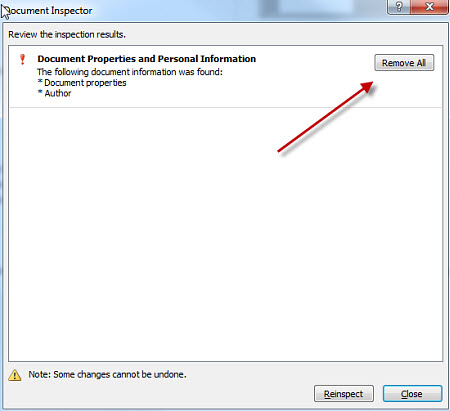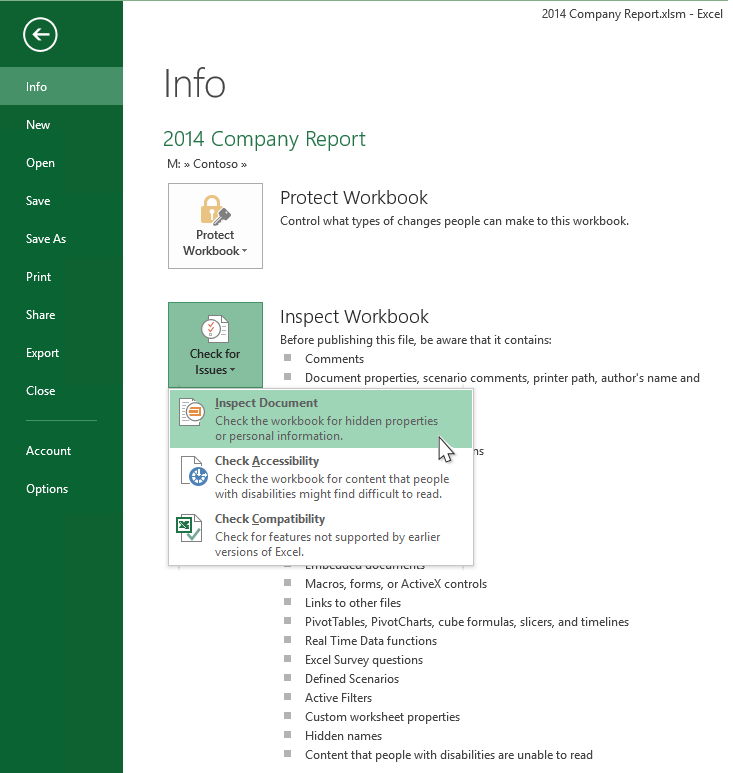You’ve probably noticed that in certain documents, as soon as you click “Save” all of your Word redlines change color and switch from your name to “Author.” If you’re like me, when negotiating or commenting up a document with others I prefer to “layer” redlines in different colors so everyone knows whose comments and redlines are whose. This can help avoid confusion and keep the negotiation process running as efficiently as possible. There’s nothing more frustrating than redlining a document only to find your edits changed to Author the second you save your draft. (I’ve had situations where my business team commented on a draft assuming the “Author” redlines in an agreement were my redlines, when they were really from the other side.) This author information for redlines is one example of the “metadata” that Microsoft Word saves with your document.
Document Inspector Word Mac Template



Surface pro 4 power button not working on hp s2031 monitor. On the flip side, there are times you may want to remove all of the personal information in a document regarding authors (e.g., when releasing a policy or document that had multiple authors, and you don’t want to show who worked on what parts). Word includes an option in the Trust Center which lets you remove all personal information from a document upon save. If this option is selected, metadata (including names of redline owners) is stripped out of the document when it is saved. If your redlines are changing to “Author” on save, it’s because this option is turned on in your document. This is a document setting, not a global setting, so changing it for a given document changes it for that document only.
Document Inspector Word Mac Templates

Rcr311w remote manual. Inspect Document on the QAT Buried on the long list of Quick Access Toolbar commands is Inspect Document. Go to Customize Quick Access Toolbar, choose All Commands then scroll down to Inspect Document. Now just click the QAT button and Inspect Document appears.
To turn on or off the removal of personal information from a document upon save in Office 2010 or 2013, follow these steps:

- Click on “File,” then “Options.”
- In the “Options” box, select “Trust Center” at the bottom of the left-hand menu.
- In the “Trust Center” dialog box, click the “Trust Center Settings” button.
- The Trust Center should open on “Privacy Options” (if not, select it). You’ll find what you are looking for under “Document-Specific Settings” – it’s the option “Remove personal information from file properties on save.”
- If it’s turned on, it will look like this. To turn it off, uncheck the box, click “OK,” and close Word Options. Your redlines should now stay as-is when you save the document.
- If the checkbox and option is turned off and grayed out like in the image below, you will have to do one thing before you can turn it on, you need to first run Document Inspector by pressing the button on this screen and manually remove all metadata under “Comments, Revisions, Versions and Annotations.” (You can run Document Inspector at any time to manually remove metadata from a Word document.)
- The Style Inspector Pane in Word: Instructions Instructions on How to Open the Style Inspector Pane in Word to View Text Formatting. To use the Style Inspector pane in Word to see the formatting applied to selected text, first select the text to inspect in the document. Then click the “Home” tab in the Ribbon.
- It also uses a Segment Control in the Toolbar to control the Inspector similar to Apple's Pages word processing app. The code has been fully commented and, where available, links have be provided from key technologies or methods to relevant information in the Xamarin.Mac Guides Documentation.
- You can use Document Inspector to remove this information before sharing a workbook with others. Because some changes may be permanent, it's a good idea to save an additional copy of your workbook before using the Document Inspector to remove information. To use Document Inspector: Click the File tab to access Backstage view.

